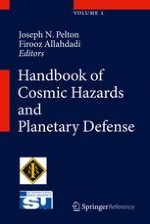2015 | OriginalPaper | Buchkapitel
Risk Management and Insurance Industry Perspective on Cosmic Hazards
verfasst von : Scott Ross
Erschienen in: Handbook of Cosmic Hazards and Planetary Defense
Aktivieren Sie unsere intelligente Suche, um passende Fachinhalte oder Patente zu finden.
Wählen Sie Textabschnitte aus um mit Künstlicher Intelligenz passenden Patente zu finden. powered by
Markieren Sie Textabschnitte, um KI-gestützt weitere passende Inhalte zu finden. powered by
Abstract
“A good rule of thumb is to assume that everything matters.” Richard Thaler
